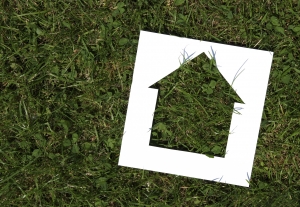With the kids heading back to school it may be time to make some footprint-reducing home improvements before the winter months settle in. Whether you’re painting a bedroom, installing landscaping, or building a brand new wing, make sure you take sustainable principles, including the ones below, into account.
Rethink Your Indoor Space
1. Paint your rooms – the green way. Give your rooms a new coat of paint while you can still have a nice breeze through an open window.. It will lighten your mood light during the darker season. But be sure to watch your carbon footprint by reducing your paint waste and opting for recycled, certified choices! With a carbon footprint of 29 kg of CO2e per gallon, wasted paint in the USA creates over 720,000 tons of CO2e per year, the equivalent of putting 150,000 extra cars on the road.
- Go for certified eco-friendly paint to reduce your carbon footprint. Paint production processes (rather than paint evaporations) during use contributes the most to paint’s carbon footprint. By getting certified eco-friendly paint you can ensure that the production process has minimal impacts on the environment.
- Opt for mis-tints or recycled paint whenever possible. Mis-tints are custom-mixed paints which the store got a little wrong for a customer. So if the slightly off tint could work for you, consider looking at buying these paints to save them from the landfill, and save you 70-80%.
- Give away your leftover paint to The Global Paint for Charity. Theywill use it for global housing rehabilitation projects. Otherwise, turn to big construction stores to help you recycle.
2. Reduce your carbon footprint with easy 1-2-3 window maintenance. This is an easy way to let more heat in the winter and create a cozy atmosphere!
- First to let the light in, clean the windows and remove screens from south-facing ones. That way, your home can absorb plenty of ambient heat in the winter.
- Second, caulk and insulate each pane to keep the cold out. There are plenty of insulation sets available in stores, including eco-friendly caulk.
- Finally, switch to heavier drapes for warmth. Drapes cut down on drafts and provide a nice transition into the colder season.
3. Optimize your space. Most of us utilize less than 40% of our living space on a regular basis. Providing supplemental heat to the rooms used the most instead of keeping the temperature high in the whole house can reduce heating bills by 20-40%. You can’t manage what you don’t measure. Start by auditing you power use and calculating your carbon footprint.
- Avoid heating/cooling unused spaces such as guest rooms,attics, and storage. Why drive up your consumption? Close the vents and the doors to these rooms.
- Load up on stylish cardigans and chic throw blankets. Then, lower your thermostat by 1°C. You’ll create a cozy atmosphere, save approximately 3% on your heating bill, and begin to reduce your carbon emissions.
- Use your ceiling fans to push warm air back down from ceiling level into your living area. This heats up the living space with less energy than your furnace.
Keep Your Heat and Cool Inside
4. Insulate your home and save from 5% to 30%of your energy per year! For example, if you added up all the cracks and gaps in an average Victorian home, it would be the equivalent of having a 1x 1.5 meter open window. Home energy use the second largest part of your carbon footprint, so reducing drafts and air leaks will have a positive effect on the level of your carbon emissions.
- Search the house for air leaks and caulk them. The most common places for air leaks are the attic and the basement. While you are at it, weather strip your doors.
- Insulate your floors above the garage. Here is how: seal all possible sources of air leakage and install an air barrier to prevent cold air in the garage from passing through the insulation underneath the subfloor.
- Insulate ducts passing through unconditioned spaces. If you’re building a new house, place ducts in the conditioned space to avoid the energy losses associated with most duct systems.
You can see the impact of your improvements on your carbon footprint this coming season by entering your zip code and your bill amounts into our carbon footprint calculator.
5. Switch to a high-efficiency heater/air conditioner. Spot-heating or cooling can help you save as much as 15% of energy used for that purpose.
- Invest in a solar heater – it’s a safe, simple, and inexpensive device. They do not require additional fuel, so they produce almost no carbon emissions.
- Energy-efficient infrared heaters are also a great option. They convert over 90% of input energy directly into radiant heat and emit no greenhouse gases.
- Update your home with an electric fireplace. Usually, we advise against fireplaces because burning wood to heat a home can emit up to 250 times as much methane then produced when burning coal in a power plant. Luckily, electric fireplaces have smaller carbon footprint. They are amazing in all seasons, since the flame display can remain on without heating.
- Install a programmable thermostat. Nearly half of the energy in your home is used for maintaining a comfy temperature. Traditional thermostats are not up to the task of micro-managing your indoor climate. A programmable thermostat, like SmartStat, will let you do just that hassle-free. For best performance, keep your thermostat away from drafts, sunlight, and exterior walls.
While we should be doing everything we can to make our heating less energy intensive, most people still use some amount of power from the grid. Often, this energy comes from non-renewable sources. Consider Terrapass Renewable Energy Credits to balance your impact and support clean power.
Keep Your Appliances In Check
6. Investing in energy efficient-appliances and keeping them well-maintained will minimize your energy use and prolong their lifespan.
- EnergyGuide labels on refrigerators, ovens, and microwaves make it simple to select the most environmentally-responsible product.
- Clean and replace dirty heater filters. Dirty filters are the main cause of furnace inefficiency. They force your system to work extra hard to push air through the dirt, while producing the same amount of heat. It will drive your utility bill and carbon emissions up. The S. Department of Energy (DOE) advises replacing the filter every 3 months and before seasons of heavy use like summer and winter.
- Investing in solar power is one of the best upgrades you can make. With solar energy, there are minimal carbon emissions and modern solar panels perform better when there is snow on the ground.
Reduce Waste From Water Systems
7. Maintain your water heating system. Water heating currently represents up to 17%of national residential energy consumption, making it the third-largest energy user in homes. In 5 years, better water heaters, are expected to help USA avoid 4.2 million tons of CO2 emissions. That’s the same amount of emissions as produced by supplying about 520,000 homes with electricity for the whole year! [toggle title=”Find out easy water heating system upgrades”]
- Update your bathroom with a drain water heat recovery (DWHR) system. Do you hate waiting for the warm water to reach the shower? DWHR preheats the water that enters the house when you are taking a shower by recapturing heat from the water going down the drain. It can decrease the energy used by your water heater by 20% or more.
- Wrap your hot-water pipes to reduce heat loss. Use pipe insulation wrap or polyethylene or neoprene pipe sleeves.
- Reduce your water heater temperature and make sure there are no leaks. This ensures you avoid water damage and only heat your water – not the boiler room around it. Plus, reducing leaks will decrease your both your carbon and water footprints.
The same way we reduce our carbon footprint and offset the remaining emissions, we should strive to minimize our water footprint and balance our water consumption with BEF Water Restoration Certificates®.Find out more here.
Don’t stop there. When determining your home improvement needs, be sure to check out the Terrapass carbon calculator. Like us on Facebook and share how you are preparing for the next season. And for more eco-friendly tips and information, visit our website, tweet us @Terrapass, and take a look at our Pinterest boards!
Brought to you by terrapass.com
Featured image
Sources:
https://greenhomeguide.com/
https://www.thisoldhouse.com/toh/article/0,,1589664,00.html
https://www.nolo.com/legal-encyclopedia/green-remodeling-eco-friendly-home-30161.html
https://energy.gov/energysaver/articles/tips-kitchen-appliances
https://www.livestrong.com/article/137686-the-best-eco-friendly-space-heaters/
https://infratech-usa.com/infrared-basics/
https://www.newlifepaints.com/carbon-impact-of-waste-paint-the-stats











